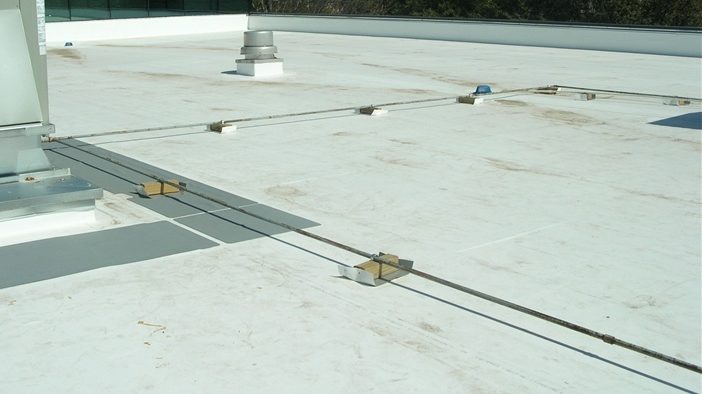
TPO is barely over 36 years since its invention and has been able to make waves and a name for itself. Many love it for its flexibility while some love it for its many colors.
TPO is a pshort form for Thermoplastic Polyolefin. It is created from talc carbon filler and EPR (Ethylene polypropylene). It comes in different thicknesses ranging from 40 -80 mils.
You can install TPO in 3 ways:
Cost
Compared to other flat roofs, TPO is less costly and more affordable, whether for a commercial or residential building. It is totally inexpensive not just in buying, it is also less costly in installation (labor, stress, etc).
Flexibility
One great advantage of TPO is flexibility. Aside from being useful in residential homes, TPO can also be used in commercial roofing. The fact that it can be used on any kind of roofing is a plus amid its ability to adapt to any kind of temperature and any kind of building.
Variations in color
Unlike EPDM which mostly come in black colors, TPO has several colors that you can pick from and install on your roof. You can get white, gray, black and many other colors.
While the white has been proven to be UV resistant, that is, it reflects sunlight better, you can pick from its many colors. You will surely find a color that compliments the color of your building.
Easy Maintenance
TPO is easy to maintain. It doesn't allow mold to grow, it is not easily punctured, and has a hard layer so it doesn't tear easily.
When you install TPO as your flat roof, you can easily maintain it yourself or call a roofing contractor. The recommended time for maintenance is twice per year.
Easy Installation
As stated earlier, there are 3 different ways to install a TPO flat roof. It is easy knowing that you can use any of the methods to install your roof immediately.
Compared to other roofs, TPO is easy to install. While other flat roofs can use these installation methods, the materials are different so the installation time and stress are different. TPO layers stick easily which makes them easy to install.
Energy Savings
The reflective membranes of TPO and its UV resistance made it one of the top choices for homeowners whenever they're considering roofing their commercial or residential home.
As you know, it has different colors. The white color surpasses the requirements of the Environmental Protection Agency’s ENERGY STAR requirements. As for the gray and other colors, they have been regulated with Cool Roof Rating Council
Varying qualities
There are several qualities of TPO available in the market. This is because they are from different suppliers and TPO is still undergoing several tests. Even though it's been around for over 36 years, there is still a lot of research carried out concerning it.
Unlike other flat roofs where the qualities are almost the same, if not the same, in the case of TPO, there can be a large disparity and this disparity can mean less quality. And when it is of less quality, it means it will surely underperform.
In this case, you should buy your TPO from good and authentic manufacturers. You can do this by asking for recommendations from people or better still, tell your roofing contractor to get you a good one.
Thickness differences
It's been said that the thicker the TPO, the longer it will last. While that is a good stand, it is not always the case.
As stated earlier, the thickness of TPO ranges from 40 - 80 mils. Now, ordinarily, a 60 mils TPO should last longer than a 50 mils TPO. But that has proven negative several times. So, the thickness of a TPO does not really determine how long it will last.
Except if you are buying the different thicknesses from the same company. Most times the causes are disparity in manufacturing and quality. So, for TPO, it's not about thickness, rather, it is about quality.
Lamination
The upper part of a flat roof is laminated. The lamination alone shows weaknesses and problems that TPO can develop. Examples of the problems are cracks, shrinkage, and deterioration as time goes.
Fire Resistance
While it is true that TPO has a class A fire rating, the material itself does not have fire extinguishing features like PVC or EPDM. Except when used in a ballasted roof system or when a fire retardant is used before placing TPO on the roof.
Slippery
If you like walking on your roof, TPO is not a good option. You might walk on your roof to maintain it or maybe clear the drain, or whatever reason. You might even have a roof garden or a relaxation area on your flat roof.
When rain or snow falls, your TPO through its drainage system drains the water. But after draining the water, it still has a wet surface. So, if you step on it without a firm step, you might fall. As you know, your flat roof might start leaking or get damaged because of the force you exerted on it when you fell.
TPO, despite the cons attached to it, is still a great flat roof option. In fact, many commercial and residential building owners choose TPO as their primary roof. This shows that at times, the pros can override the cons of TPO.
For installation and maintenance of TPO, you should contact a professional roofer so you won't run into problems in the future. You can contact us for a free quote and consultation. If you also want to install TPO on your commercial or residential roofing, contact us at 1274 5th Ave New York, NY 10029, (212) 457-1324, [email protected]